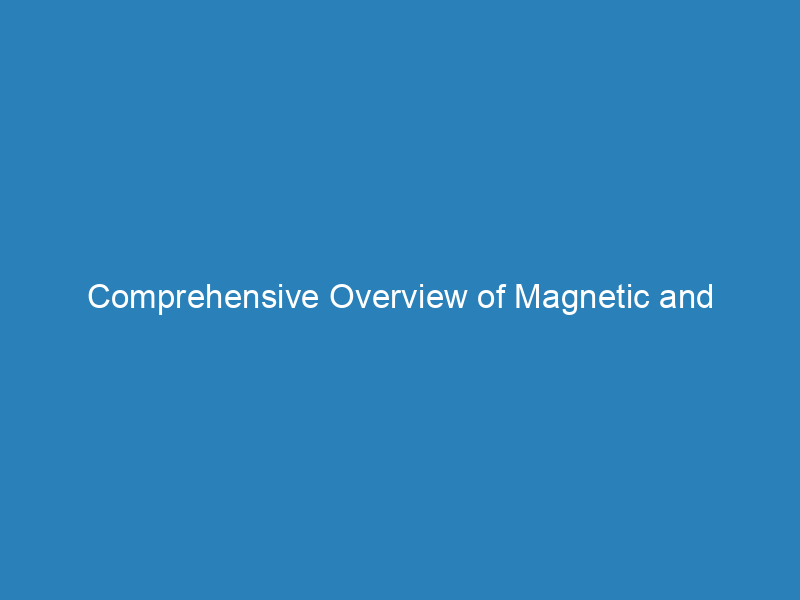
Comprehensive Overview of Magnetic and Non-Magnetic Metals: Properties, Types, and Applications
Metal products play a crucial role in numerous industries, and understanding the different types of metals and their properties is essential for both consumers and manufacturers. This article delves into the fascinating world of magnetic metals, exploring what makes certain metals magnetic, the types of magnetism, and the various applications of these materials.
Understanding Magnetism
Magnetism arises from the movement of electric charges, leading to attractive and repulsive forces between objects. For a material to exhibit magnetic properties, it must possess a distinct north and south pole. Opposite poles attract, while like poles repel each other. The region around a magnet that displays this magnetic force is referred to as the magnetic field.
Types of Magnetism
To gain a deeper understanding of magnetic materials, it’s useful to categorize the different types of magnetism:
- Diamagnetism: Materials that are weakly repelled by magnetic fields.
- Paramagnetism: Materials that are weakly attracted to magnetic fields.
- Ferromagnetism: Materials that are strongly attracted to magnets and can be magnetized themselves.
- Ferrimagnetism: Materials that are attracted to magnets and can act as permanent magnets.
- Antiferromagnetism: Materials that are not attracted to magnetic fields at low temperatures but become weakly magnetic at higher temperatures.
The Magnetic Nature of Metals
For a metal to be magnetic, its atomic structure must allow for the alignment of its atoms in a uniform direction. This alignment occurs when there is an uneven distribution of electrons that creates magnetic dipoles. When these dipoles align, they form localized magnetic domains, which together generate a magnetic field capable of attracting ferromagnetic metals. The stronger the alignment of electrons, the more robust the resulting magnetic field.
Classification of Magnets
Magnets can be categorized based on their magnetic properties:
- Permanent Magnets: Naturally occurring elements or compounds that maintain their magnetism.
- Temporary Magnets: Materials that become magnetized in the presence of a magnetic field but lose this property once the field is removed.
- Electromagnetic Magnets: Require an electric current passed through wire coils to generate a magnetic effect.
Magnetic vs. Non-Magnetic Metals
The three primary elemental metals known for their natural ferromagnetism are:
- Iron: The most abundant element on Earth, iron is essential in creating steel alloys and is widely used in construction and manufacturing.
- Cobalt: Known for its corrosion resistance, cobalt is used in alloys and applications such as jet turbine generators.
- Nickel: Valued for its resistance to heat and corrosion, nickel is commonly found in batteries and other high-performance applications.
On the other hand, metals like aluminum, copper, lead, and tin are classified as non-magnetic, along with alloys such as brass and bronze.
Common Magnetic Metals
Here are some key magnetic metals and their applications:
- Iron: Used in steel production and various engineering applications.
- Nickel: Commonly found in batteries and coins, it is crucial for alloy creation.
- Cobalt: Essential in high-performance applications such as jet engines and cancer treatments.
- Steel: A strong and versatile alloy primarily used in construction.
- Stainless Steel: Durable and resistant to corrosion, used in medical and household items.
- Gadolinium: Employed in MRI machines and nuclear reactors for its alloy-strengthening properties.
- Dysprosium: Known for its resistance to demagnetization, making it valuable in advanced technologies.
Exploring Non-Magnetic Metals
While some metals are inherently magnetic, others are not. Non-magnetic metals include:
- Aluminum: Lightweight and versatile, ideal for applications in aviation and packaging.
- Brass: A durable alloy of copper and zinc, widely used for its aesthetic appeal and corrosion resistance.
- Bronze: A malleable alloy of copper and tin, suitable for architectural applications and musical instruments.
- Copper: Known for its excellent electrical conductivity, used in wiring and plumbing.
- Gold: Valued for its rarity and resistance to corrosion, prevalent in jewelry and electronics.
- Silver: Used in jewelry and mirrors, known for its high reflectivity and conductivity.
- Zinc: Commonly used for galvanizing iron to prevent rust.
Get Quality Metal Products
If you’re in need of magnetic metals, various suppliers specialize in high-quality metal products. From cold-rolled steel to stainless steel variations, you can find what you need for any project. Whether you’re a small shop requiring a few pounds of metal or a larger manufacturer needing a significant volume, numerous service centers are equipped to assist you.

